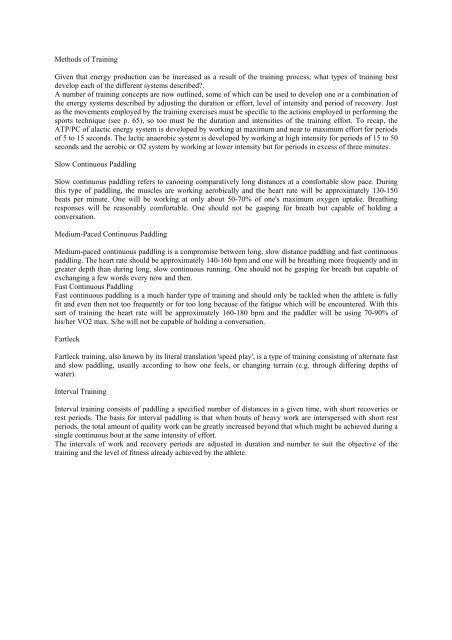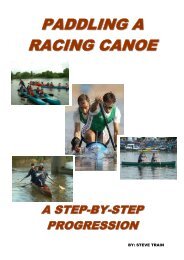The Science of Canoeing By Richard Cox
The Science of Canoeing By Richard Cox
The Science of Canoeing By Richard Cox
Create successful ePaper yourself
Turn your PDF publications into a flip-book with our unique Google optimized e-Paper software.
Methods <strong>of</strong> Training<br />
Given that energy production can be increased as a result <strong>of</strong> the training process, what types <strong>of</strong> training best<br />
develop each <strong>of</strong> the different systems described?.<br />
A number <strong>of</strong> training concepts are now outlined, some <strong>of</strong> which can be used to develop one or a combination <strong>of</strong><br />
the energy systems described by adjusting the duration or effort, level <strong>of</strong> intensity and period <strong>of</strong> recovery. Just<br />
as the movements employed by the training exercises must be specific to the actions employed in performing the<br />
sports technique (see p. 65), so too must be the duration and intensities <strong>of</strong> the training effort. To recap, the<br />
ATP/PC <strong>of</strong> alactic energy system is developed by working at maximum and near to maximum effort for periods<br />
<strong>of</strong> 5 to 15 seconds. <strong>The</strong> lactic anaerobic system is developed by working at high intensity for periods <strong>of</strong> 15 to 50<br />
seconds and the aerobic or O2 system by working at lower intensity but for periods in excess <strong>of</strong> three minutes.<br />
Slow Continuous Paddling<br />
Slow continuous paddling refers to canoeing comparatively long distances at a comfortable slow pace. During<br />
this type <strong>of</strong> paddling, the muscles are working aerobically and the heart rate will be approximately 130-150<br />
beats per minute. One will be working at only about 50-70% <strong>of</strong> one's maximum oxygen uptake. Breathing<br />
responses will be reasonably comfortable. One should not be gasping for breath but capable <strong>of</strong> holding a<br />
conversation.<br />
Medium-Paced Continuous Paddling<br />
Medium-paced continuous paddling is a compromise between long, slow distance paddling and fast continuous<br />
paddling. <strong>The</strong> heart rate should be approximately 140-160 bpm and one will be breathing more frequently and in<br />
greater depth than during long, slow continuous running. One should not be gasping for breath but capable <strong>of</strong><br />
exchanging a few words every now and then.<br />
Fast Continuous Paddling<br />
Fast continuous paddling is a much harder type <strong>of</strong> training and should only be tackled when the athlete is fully<br />
fit and even then not too frequently or for too long because <strong>of</strong> the fatigue which will be encountered. With this<br />
sort <strong>of</strong> training the heart rate will be approximately 160-180 bpm and the paddler will be using 70-90% <strong>of</strong><br />
his/her VO2 max. S/he will not be capable <strong>of</strong> holding a conversation.<br />
Fartleck<br />
Fartleck training, also known by its literal translation 'speed play', is a type <strong>of</strong> training consisting <strong>of</strong> alternate fast<br />
and slow paddling, usually according to how one feels, or changing terrain (e.g. through differing depths <strong>of</strong><br />
water).<br />
Interval Training<br />
Interval training consists <strong>of</strong> paddling a specified number <strong>of</strong> distances in a given time, with short recoveries or<br />
rest periods. <strong>The</strong> basis for interval paddling is that when bouts <strong>of</strong> heavy work are interspersed with short rest<br />
periods, the total amount <strong>of</strong> quality work can be greatly increased beyond that which might be achieved during a<br />
single continuous bout at the same intensity <strong>of</strong> effort.<br />
<strong>The</strong> intervals <strong>of</strong> work and recovery periods are adjusted in duration and number to suit the objective <strong>of</strong> the<br />
training and the level <strong>of</strong> fitness already achieved by the athlete.



